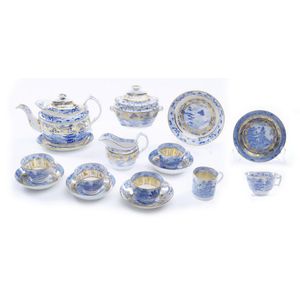Herculaneum Porcelain Tea Set with Pagoda Decoration
You must be a subscriber, and be logged in to view price and dealer details.
Subscribe Now to view actual auction price for this item
When you subscribe, you have the option of setting the currency in which to display prices to $Au, $US, $NZ or Stg.
- Coffee Can - A coffee can is a cup for holding coffee, but of a cylindrical shape rather than the waisted shape of traditional cups. They were in use at the end of the 18th century and in the early 19th century.
- Transfer Printed / Decorated Transferware - Transfer printing is method of decorating ceramics, reducing the cost of decoration when compared to employing artists to paint each piece. A print was taken on transfer-paper from an engraved copperplate, covered in ink prepared with metallic oxides, and the image on the paper was then applied to the biscuit-fired ceramic body. The print was fixed by heating the object in an oven, and then glazed, sealing the picture. Early transfer prints were blue and white, as cobalt was the only colour to stand firing without blurring. Early in the 19th century advances in the composition of the transfer paper resulted in better definition and detail, and enabled engravers to combine line-engraving with stipple.
- Circa - A Latin term meaning 'about', often used in the antique trade to give an approximate date for the piece, usually considered to be five years on either side of the circa year. Thus, circa 1900 means the piece was made about 1900, probably between 1895 and 1905. The expression is sometimes abbreviated to c.1900.
This item has been included into following indexes:
Visually similar items

The Beatles: Complete set of 'The Best of the Beatles' Porcelain Music Box Collection by Franklin Mint, new in box (12 items).

A large Chinese bowl, under glaze blue with bird in peony. Together with smaller with panels of landscape together with a bowl and two other Chinese plates and bowl. Large bowl 28 cm wide.

A Chinese under glaze blue brush pot with continuous landscape. Together with a jar, cover, candle holder and two plates, one with fish decoration the other with quail. Brush pot 13 cm high.

Brownie Downing, pair of porcelain condiments, side plate, three pin dishes, and a plaque, Side plate: 15.5 cm diameter
